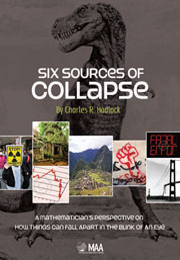 Six Sources of Collapse
Six Sources of Collapse Book contents
- Frontmatter
- Preface
- Acknowledgements
- Contents
- 1 Introduction
- 2 Predicting Unpredictable Events
- 3 Group Behavior: Crowds, Herds, and Video Games
- 4 Evolution and Collapse: Game Playing in a Changing World
- 5 Instability, Oscillation, and Feedback
- 6 Nonlinearity: Invitation to Chaos and Catastrophe
- 7 It's All About Networks
- 8 Putting It All Together: Looking at Collapse Phenomena in “6-D”
- References
- Index
- About the Author
Preface
- Frontmatter
- Preface
- Acknowledgements
- Contents
- 1 Introduction
- 2 Predicting Unpredictable Events
- 3 Group Behavior: Crowds, Herds, and Video Games
- 4 Evolution and Collapse: Game Playing in a Changing World
- 5 Instability, Oscillation, and Feedback
- 6 Nonlinearity: Invitation to Chaos and Catastrophe
- 7 It's All About Networks
- 8 Putting It All Together: Looking at Collapse Phenomena in “6-D”
- References
- Index
- About the Author
Summary
The world is a fascinating combination of fragility and resilience. In the midst of terrible wars and atrocities and countries being torn apart, we also see images of children playing soccer in the street and young couples starting futures together at wedding celebrations. The signs of past collapses are all around us, but we keep building new lives, structures, and institutions to take their place.
This is a book about collapse. It's intended to help some of us manage collapse a little better, promoting it when we want to and protecting ourselves from it when we need to. The first step is to understand it better, using different tools and different points of view. Much of this book is about history and experience — the anatomies of past collapses in many different subject areas from finance to fighter jets, networks to nanostructures. In surveying these diverse cases, we find extraordinary commonalities. The same kinds of dynamics occur over and over again.
Let me explain why my background as a mathematician gives me a particular perspective on this subject. Some people think that math is all about solving equations, but they're dead wrong. Math is much more about identifying common features and describing them in a way that captures their essence. Mathematical symbols and equations are basically a language that helps to clear away some of the detail so we can focus on those fundamental underlying features or principles.
- Type
- Chapter
- Information
- Six Sources of CollapseA Mathematician's Perspective on How Things Can Fall Apart in the Blink of an Eye, pp. ix - xPublisher: Mathematical Association of AmericaPrint publication year: 2012


